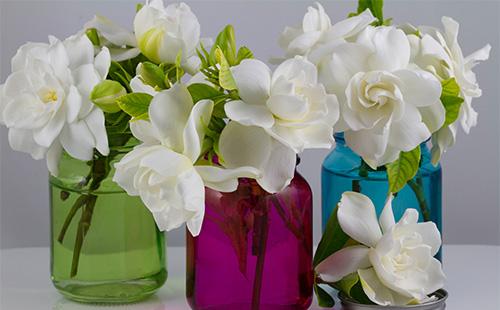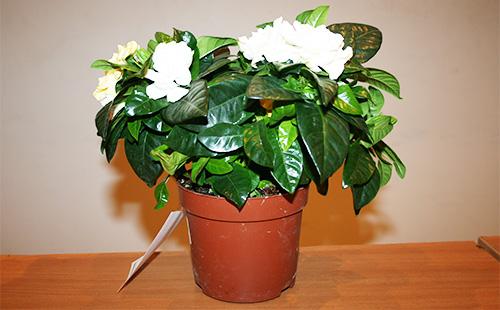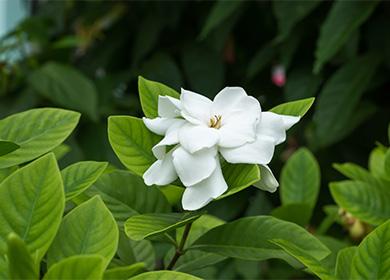The content of the article
This is a plant of aristocrats. Several centuries ago, exquisite flowers showed off on the ball gowns of noble ladies, frock coats of wealthy men. For this, the culture was called "flower in the buttonhole."
Belongs to the Marenova family. It is found in nature in the form of an evergreen shrub or small tree. He loves moisture, therefore settles where it is enough - in areas with a subtropical climate. Wild culture can be seen in India, Japan, China, here it is landscaped with gardens. Beautiful flowers exuding a delicate aroma, lush bright green dome of leaves - it is simply impossible not to notice the magnificent shrub.
Not in all countries a flower is considered exclusively decorative. In China, for example, it is used in folk medicine. Local healers prepare decoctions of the roots and fruits of the plant. This medicine saves you from fever and migraines, helps with problems with the respiratory tract, relieves fatigue and relieves insomnia. It is believed that blooming gardenia creates a calm atmosphere in the house, helps to forget about problems and relieves depression.
Flower characteristic
In nature, the shrub grows to almost 2 m. But on the windowsills it does not extend more than 50 cm. The plant has beautiful leaves - green, glossy, wide. Flowers resemble jasmine both externally and in aroma. For this similarity, this variety of gardenias got its name. The flowers are large, can be located singly or collected in inflorescences of four to six pieces.
When fussy likes the climate, it blooms for more than three months. Subtle flowers usually appear in July and fall at the end of October. The efforts of breeders have bred several varieties that delight in flowers twice a year (for example, Amy).
Care
Gardenia usually gets into a house already blooming - in this form it is most often sold in stores and greenhouses. You need to choose a suitable window for the flowerpot. Experienced gardeners recommend the southwestern or southeastern - there is a lot of light that is needed by a beautiful guest. Remember, you need a permanent place: this lady does not like moving. From a change of residence, she languishes, drops leaves and buds, stops blooming.
It is advisable to quarantine for at least two weeks and not to add neighbors to the new pet. This will help prevent infection by insects. Do not immediately actively water the plant, feed it - let it get used to a new place.
Lighting
Such a photophilous plant still needs to be looked for. This is one of the main difficulties in growing. Lighting should be bright, but the culture does not tolerate direct sunlight, expressing "fi" with fallen leaves and flowers. The main problems begin in the winter: because of the short daylight hours, cloudy weather, the bush does not have time to be saturated with the sun and begins to “feel sad”.In the cold season, you must definitely highlight the plant.

Temperature mode
Almost all varieties of jasmine gardenia that are grown on window sills are thermophilic. In summer, the ideal temperature regime for the plant is + 21-24 ° C. When the bush fades and goes into a state of rest, the daytime temperature must be reduced to + 18 ° C, and another two degrees at night. This mode is ideal for laying buds that bloom in the spring. If wintering takes place at temperatures above + 21 ° C, then they will form weakly, in the spring of active growth and a riot of greenery you will not see.
Watering
Watering is necessary depending on the season. Inexperienced flower growers are often mistaken in this matter, which leads to the loss of a flower. Remember the rules:
- vegetation - plentiful watering immediately after drying of the topsoil;
- cold season - moderate, after drying the earthen mixture from above, wait two days (it is dangerous to overfill and dry).
For irrigation, you need to use settled water. It is important that its temperature is a couple of degrees higher than room temperature. Gardenia especially likes a slightly acidic liquid: add two drops of lemon juice or citric acid to the tip of a knife in a liter container.
Humidity
A flower loves when the air is humid. Spraying will help to increase the rate. However, you can spray only before the flowers begin to bloom. Moisture will spoil delicate inflorescences: water that has got on the buds provokes the appearance of brown spots, due to which decorativeness is lost. A flowering plant is placed on a pallet with wet peat or expanded clay, the leaves are wiped with a damp soft cloth.
Top dressing
Young plants are fed once every 14 days. Use the alternate method: once mineral fertilizer, the second - organic. Adult specimens need weekly nutrients during the growing season. Feeding is stopped with the onset of frost - the aristocrat begins a period of rest.
Pruning
When the bush fades, it must be cut off, otherwise it will lose its decorative effect. Shoots cut no less than half. Be sure to remove the stems with faded flowers, weak. During the growing season, you need to pinch young shoots: this will form a beautiful bush.
Transfer
Frequent transplants can only harm a demanding culture. The bush is transplanted as it grows. A new house needs a flower if the root system has grown and filled the entire pot. Usually this is signaled by the cessation of plant growth. It can be determined that the beauty has little space and the roots are knocked out of the drainage holes. Young specimens may require an annual transplant. Adult plants usually need a change of residence every two, or even three years. The transplant must be carried out according to the rules, then the gardenia will quickly get used to the new “house”.
- Optimal time. It is recommended to transplant in early spring, before flowering. During the budding period, it is better not to disturb, otherwise you can never wait for the flowers. If necessary, a transplant is done after flowering.
- Pot selection. The pot should be slightly larger than the previous one: a flowerpot only 4 cm larger than its predecessor in diameter will do. If there is too much space, the roots will begin to grow actively, and the plant will not have the strength to form a crown and continue flowering. It is better not to take a clay pot - the roots in it can be supercooled. Buy containers with drainage holes.
- Drainage. Be sure to buy a drainage and fill it with the bottom of the pot into which you plan to transplant the pet. This will protect against root decay.
- The right soil. Gardenia loves acidic soil (pH from 4.5 to 5.5), loose. From purchased soil mixtures, soil for azaleas is suitable. You can prepare the soil yourself, taking turf, leaf, coniferous, peat land and sand (all in equal parts). Remember that a slightly acidic soil mixture gradually leaches out. Watering it with the addition of a couple of drops of lemon juice will help to acidify it. You can insist water on peat.
It is better to transplant young specimens by transshipment in order to avoid damage to the roots. The age bush must be carefully examined and, if necessary, removed rotten and weak roots.
Breeding
It is easiest to propagate by cuttings. You can get new plants from the apical cuttings, which are half lignified. They are cut in late February - early March, when the plant is preparing to leave its dormant state. A step-by-step instruction consists of five steps.
- Pruning. Prepare the cuttings. Try to make a neat cut.
- Soaking. Dip the cuttings for half an hour in a weak solution of potassium permanganate.
- Disembarkation. Prepare the ground. To do this, mix peat and sand in equal amounts. Plant the cuttings.
- Conditions. Make a greenhouse by covering the cuttings with plastic wrap or a glass jar. The temperature in the room should not be lower than + 25 ° C. The room should be regularly ventilated. Moisten the soil as it dries by 1-1.5 cm: do not fill or dry.
- Transfer. When it is possible to root the stalk (it will take about a month), transplant the sprouts into the “adult” soil. In order to quickly grow new plants, you can treat the roots with a growth stimulator before planting.
Difficulties
As soon as the coquette doesn’t like something, it immediately lets you know about it with its drooping look. The main thing is to understand in time what is wrong and fix it. The most common difficulties experienced by gardeners and their causes are reflected in the table.
Table - Problems with gardenia cultivation and their causes
| Problem | The reasons |
|---|---|
| Leaves turn yellow | - Watering too hard water; - soil hypothermia; - temperature changes |
| Yellow stains appear on the leaves | Soil acidity has fallen |
| Leaves turn black and fall | - Waterlogging; - low temperature; - draft |
| Leaves turn pale | - Low temperature; - too much moisture |
| Buds fall | - Irregular watering; - drying of the soil; - low temperature; - little light; - rearrangement of a flowerpot |
| Does not bloom | - Not enough nutrients; - not enough light; - dry air; - alkaline soil; - the plant is not cut; - the air temperature during wintering was above + 17 ° С |
| Not growing | - Too small pot; - lack of nutrients |
Diseases and Pests
Gardenia is often sick. The plant is “loved” by pests. The sooner a problem is identified, the higher the likelihood that a green pet will be saved.
Diseases, pests and their manifestations:
- Putin tick - the leaves dry, a web appears;
- thrips - grayish dots on the top of the sheet;
- scale shield - brown spots on the leaf plate;
- aphid - a sticky coating appears on the buds and apical shoots;
- soot fungus - black coating on the leaves;
- root rot - the plant becomes weak, dries up.
In case of infection with insects and fungi, there is only one way to reanimate the culture: by removing the affected areas and treating with insecticides. The most effective drugs are Inta-Vir, Actellik, Decis, Fitoverm. If the lesion is negligible, then just one spray. If you do not react in time, then you will have to save the plant for a long time: spraying is carried out three times, the interval between procedures is ten days. You can prevent diseases and the appearance of insects by providing proper care to the plant. In particular, it is important not to flood the bush.
The "occupational disease" of gardenia is chlorosis. If green veins are visible on the yellowing plates of the leaf, the attack has not passed your beauty. The disease occurs due to a lack of iron in the soil, so it is recommended to regularly fill the soil lump with iron-containing preparations.

Reviews
The fragrance is delicious and strong. Despite its small size, the flower exudes a very strong smell. Therefore, it is better to take it out of the bedroom during flowering. I put the faded inflorescences in the closet, where they perfume my things for another week.
Gardenia loves acidic soils. The store has special soils and fertilizers for such plants. You can take the soil for hydrangeas and azaleas. Watering - frequent, soft, settled water. It will be good to add a few drops of lemon juice or citric acid to it. Good fertilizer for azaleas. If the leaves began to turn pale - this is the first sign of chlorosis. Correct all the same acid fertilizing and watering with acidified water will help. And if they turn yellow, while green veins remain, then gardenia does not have enough iron. You can buy special preparations in the store, or you can bury a few rusty (!) Nails in a flower pot.
Gardenia loves swimming. You can bathe it from the shower once a month, you can spray it with every watering. This is not difficult to do, just put a spray near the flower. The only thing is that the water does not fall on the blossoming flower - this will cause rusty spots to appear on it. Position - not direct sun, the western and eastern windows will do. The main thing is humidity. In winter, I put the pot on a plate with a layer of wet expanded clay.
Gardenia also loves fresh air, so if you can, take it outside at partial shade or to the balcony. By the way, the first time gardenia was sick - acclimatized. But then I came to my senses and delights me with its magnificent appearance and fragrant flowering!
ITA http://irecommend.ru/content/kak-priruchit-svoenravnuyu-prelestnitsu
In general, all gardenia was completely circled around me, until I learned how to properly care for it and brought out the scale shield. Water only with boiled water, spray every day in the morning, you can feed it, but I advise you to simply pour the top of the ground for roses and spill the plant, it should stand in a bright place where there are no drafts. This year, my gardenia bloomed for the first time in 5 years. And yet, it is very important to ventilate the rooms in the evening, because plants also need fresh air.
Foxwomen http://indasad.ru/forum/27-uchod-za-komnatnimi-rasteniyami/247-gardeniya-zhasminovidnaya-kak-ukhazhivat
I have long wanted a gardenia home for myself, but somehow I did not dare. I read a lot about her, that she is very picky, and I don’t have much time for her departure. But fate brought me to this flower, my sister decided to please me with this flower and presented it to me as a presentation. I was not very happy, but I got used to the idea of eternal departure.
This flower is very beautiful, it is like a small decorative jasmine bush, even the aroma during flowering is similar. But the flowering itself is much more than that of jasmine.
Well, picky this flower, it's just awful. To contain it, you need to maintain the temperature in the room no more than 24 degrees. Pour it only with boiled water, and even with the addition of drops of lemon. Water it often, but you can not fill it, you just need to moisten the soil. This flower loves humidity in the air.He does not tolerate sunlight on hot days, but he loves the light. This flower is just a sea of contradictions in one.
But if you provide him with all these points, he will thank you with his beautiful flowering, his beauty and aroma. But I just gave it to my mother, because I have no time to look after him, it’s easier for me with ordinary flowers that you can just water and forget.
alya777, http://otzovik.com/review_2305688.html

